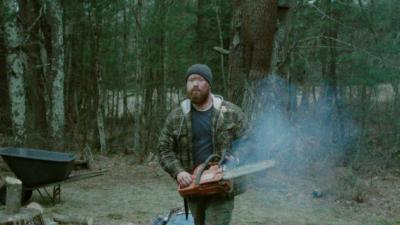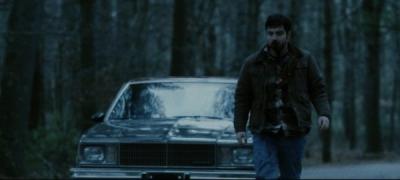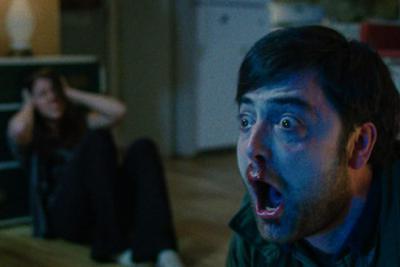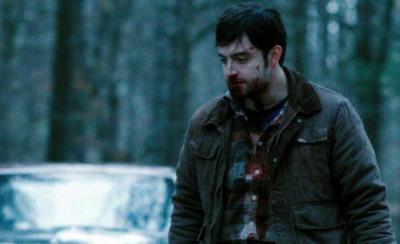By: debbie lynn elias
It’s always a treat to speak with a new voice in the filmmaking stratosphere. It’s even better when that voice has a new perspective and interpretation of a genre or story or well oiled character. And it’s a delight when that new voice is able to bring that new perspective to fruition. Such is the case writer/director/cinematographer Joe Begos and his feature film debut, ALMOST HUMAN.
Blending two wonderfully cinematic genres – alien abduction and slasher horror – Begos achieves not only chills, thrills and jump out of your seat moments and storied realism, but adds an element of humanity within his protagonist, something rarely seen amidst blood, guts and core. Despite the film’s low budget, Begos shoots in New England locations with which he is familiar, utilizing the scenery at hand to his best advantage while executing creature creation with effective practical techniques and, as luck with have it, achieving some happy accidents that bode well for the film as a whole.
Keeping the plot line simple, ALMOST HUMAN opens with an eerie and beautifully lensed disappearance/alien abduction of Mark. Leaving his best friend Seth shell shocked over his disappearance and sparking a media frenzy that quickly dissipates, two years pass and Mark suddenly, inexplicably, returns. Coinciding with his return, however, is a frenzied killing spree. Could Mark be the killer? Knowing something is amiss, Seth and his ex-girlfriend Jen, also a friend of Mark’s, fear the worst and start to dig for answers.
I had a chance to speak with Begos in this exclusive 1:1 interview talking aliens, horror, lo budget/no budget and yes, even VHS tapes.

This is a fun little project you have here with ALMOST HUMAN. I love the horror. I loved all the old school elements you bring to the table, but then you give your protagonist character Seth this really warm humanity.
Like a blue collar everyman.
Blue collar everyman, and he cares and he’s truly worried about everybody around him and what’s going to happen. We don’t see that in horror films as a rule. It’s typically bloodshed, bloodshed, bill, bloodshed. We don’t see that humanity. A beautiful element to this film and to this script. Totally unexpected.
I’m glad that you responded to it.
Where did this story come from?
I grew up in that area [New England]. I’d always been fascinated with alien abduction as a kid because it seems like if you’re going to get abducted by aliens, it’s going to be in the middle of New England in the woods. [laughing] I had this fascination with alien abductions and I knew I always wanted to make an abduction movie. When it came time, I was like, ‘Okay, we’re just gonna go make this movie. We’re gonna make it back home. What can we do for our project?’ Well, it’s gonna be an alien abduction movie. There’s only like three good ones that have been made. I really wanted to open with this abduction, slam it on the audience, knock ‘em on their ass and then we deal with the aftermath. I always wanted to make a slasher movie, too, but if you make a generic slasher movie it gets lost very easily. So, I thought a cool twist to add that so it’s almost like A Fire in the Sky Meets The Terminator. That’s what I like about The Terminator. You have this inhuman threat and then you’ve got the two human characters who are heroic. And these are just like normal people. Seth’s clocking in at his hardware store job and ten hours later he’s burying an axe in an alien! [laughing] So, I think that that adds – I like that whole aspect. That’s all I know. Growing up in a town like that, people work at hardware stores or they work at coffee chops or they mow lawns and that’s just kinda how the town is. It’s really small and everybody knows each other.
It’s also one of the great things that come into the story is your retaining that small town without making it look forced like a set. That is the rural way of life up in New England.
I just shot it. I wrote it on how my friend’s lives are. We would just go into these places like the hardware store or the diner. We did no production design. That just what it looks like. That’s just Rhode Island. [laughing] Rhode Island looks exactly like Maine. It’s almost like that section of the country is trapped in 1987 anyway. It feels like there’s been no development.
I’m surprised that you found parts of it that were like 1987 and not 1978!
[laughing] Exactly! I wouldn’t have minded doing 1978 though. That would have been awesome. I’ve read a couple of reviews where they go, ‘Oh, how convenient this town seems to have chainsaws, axes an all this other stuff.’ If you’ve ever been to my town, you walk into somebody’s backyard and they’ve got a barn full of this shit. [laughing] That’s exactly what it’s like. Everybody’s got a pick-up truck with an exe in the back, a sledgehammer.
One of the actors [Graham Skipper] who plays Seth, he’s from the middle of Texas and then he’s lived in LA and New York most of his life. He had to break the chain of the axe. And he was like, ‘I’ve never swung an axe before.’ I’m like, ‘What!!! wait, wait, wait! What!!!” Weird stuff like that. Growing up in that town, to me that’s just normal. [laughing]
So did we have to allow for axe training?
I had to go in there and swing that mother fucker and show them how it’s done.
You didn’t have to have an axe-wielding stunt double?
No, no. [laughing]

In addition to writing and directing, you did your own cinematography with ALMOST HUMAN. I love the palette that you developed. You have that sickly green pallor and denuded fabrication throughout the film but for the opening scene with the initial abduction and the inky pitch black night and the alien blue light. How did you develop that and was part of the consideration working with Josh Either and the editing that would be implemented?
We’ve been working together for awhile so we have a shorthand. When he reads a script that I wrote, I’m very detailed. I literally write in the shots and some of the staging.
You’re essentially shot listing as you’re writing then?
Yeah. I know I’m gonna be directing it so to me, if I’m writing a blueprint for making the movie, I want all that stuff in there. . .Insofar as the palette of it, to me it was very important that this be a winter movie. I love movies that take place in the winter, especially horror movies, because you see the breath. Knowing what I know, it’s like super blue. All the trees are dead. You can just look at it and you’re freezing. And the temperatures of this movie were so cold. I wanted to open the movie up. If you’re in Rhode Island at night by the fire or a night over with your friends, a very quiet pitch black night, and I wanted to just evoke that feeling that this is just a typical night but not everything is tossing its head. Then we come back and two years later this town is still at a standstill. It’s dead cold. Everything’s dead. I just thought that was an interesting way to go. I wanted to make it look like we shot this in 1987 on 16mm in the winter. I knew that going in all along so I had planned for that while we were shooting. We shot in winter. In the DI [Digital Intermediate – converts film to digital bits and back to film again], I picked a film stock from 1987 and it went in there and the entire DI was under those conditions.
Another aspect of the film that I think is exceptionally well done is the insertion of “news stories”. You have the news stories being reported on tv’s within the diner, within homes, in the hardware store. That’s where we get some pops of color that distinguishes the rural world of Seth and company from the rest of the world; like a separation off church and state. You keep that graininess of 1987 television reporting on the tv screens which works really well and adds a heightened level of period of authenticity. Did you use a different film stock for that or just work with color correction in post?
What we did with that – and its something that usually bothers me in a lot of indie movies, the news stuff always looks so fake to me, like it’s not believable – my big thing with that is, we’re gonna go out and we’re gonna shoot all this news footage a month before we make the movie. So, I went out and shot it. And what we did is that it was HD and we degraded it to standard definition, then put it up to VHS and then input the VHS back into the computer and then burn it to a DVD and played it on tv’s from the 1980’s. So in all these scenes, they’re actually watching that “news” footage on the tv. I feel like that helps add to the realism if you’re in this room where this guy is obviously watching what looks like a real newscast on a tv that looks like it’s from the 1980’s. To me, it’s just a big part of adding a sense of realism to the movie. I’m a big fan of having the actors have every single type of element around them. I don’t want them to be reacting to a blank tv or a digital ball that’s going to be added later. I want to shoot the reality of what’s going on.

Speaking of reality, with your “creature creation”, you’ve got the umbilical cords between mouths, milky semen-like coating on bodies and in pods. How did you go about designing all of that? It was so effectively done.
I wanted to keep everything as simple as possible as we had very strict budget constraints. I wanted – and needed – to keep it all as simple as possible but still be effective. So [creatures] kind of organically came from that and knowing certain camera tricks we could use to make stuff work. I’d been doing a lot of shorts so a lot of the effects were stuff I knew I had pulled off successfully before and I knew how to do. I was like, ‘I know this is gonna work. We’re not just throwing shit at the wall.’ That’s how I approached the effects in this because I knew it was going to be such a pain in the ass with a short shooting schedule and so many effects pieces.
Did you create the pod coverings? Was that practically created or did you do that with CGI?
There is not one shot of CGI in the movie. Literally, not one drop of blood. Everything was created. [With the pods] people are actually inside so it was chicken wire with a base around it and then we colored it. We slit it and then get the person in there and then glue it all back together so they actually had to rip themselves out. Then we had hot lights over it so they would be reflecting the entire time. Then we had fog machines running through the back so there would be some sort of haze coming off as they were opening up. That was all done live. It’s pretty awesome because it was so cold out that when the guy actually comes out [of the pod] his body is so warm that he’s steaming and smoking and it looks so awesome. It was so unexpected!
It looks fantastic on screen! People forget how good the practical applications look. They are becoming so jaded with CGI.
It’s so funny. While we were shooting, everybody was [making a grimace], ‘Well, this is kind of ‘okay’.’ The thing with practical effects too is that it’s never gonna look as good as you want it, but when they show up [on film] and you see what you get, it’s ‘Alright!! Now we can change the lighting, we can change the shot, we can adapt to make this look as good as possible.’ Whereas if you have CG, you’re just shooting, hoping that it’s gonna look good and then you’re stuck with that. That’s why having practical effects are: This is what we have. What’s the way we can make this look the best. That’s why when you’re watching the pods, if you were just standing in the room it was kind of ‘blech’, but if you were going to shoot it creatively and at its best, that’s why I like practical effects so much more. Not only do they look better but it allows you to figure out the best way to make it look and organically direct and add atmosphere to it.
Hands on is so much better because you do have more creative control. And I think it helps the actors to give a much more genuine performance. Here, you’ve got Graham Skipper and Vanessa Leigh as Seth and Jen who are so rooted in truth and reality, they’re very grounded. I don’t think you would have achieved that same performance level if you didn’t have the practical effects.
For sure. And there’s something about going in there and getting your hands bloody and moving shit around. It fits so cool and it gets everybody amped up to see that.

One of the fun castings is, of course, Josh Ethier, as our first victim, Mark. What led you to also have him do triple duty since he’s also producer and editor? Granted, he fits the part. Rustic mountain man with the beard. He’s very believable.
With Josh, we met each other when we were like 13, so we had just been making films since then. During that process we figured out what each one of our strengths were. Josh was a musician, well, he’s still a musician, but when I met him that was his main focus, so he had a very good rhythm of things and was very good at computer programming and stuff like that. He started cutting stuff and we would just produce everything together. Because it was usually just us making stuff and I was the director, I would just shoot and he would just act. It became something like he’s not necessarily an actor, but we have that shorthand where I know his strengths, I know what he can do well. He has a very good screen presence and I think he can do well at certain things. We knew this was going to be such a low budget and I knew he was going to be there the entire time anyway, it was going to be non-SAG, so it seemed like a no-brainer to write him as the villain.
Jumping from shorts to a feature, what was the most challenging aspect of the process for you?
Getting the money. It was mostly self-financed but I guess finding the finishing funds. We had enough money to get the movie in the can and then we had to use the cut to gradually piece together the rest of the money. That was a long process of doing that. But because we had been making shorts and I found all my main crew members – I found my AC and my sound guy and Josh – I had an all-star team of people who I always worked with so we had a very good flow, so this was just doing a short with a longer schedule. Usually we’d shoot over a weekend and now we had 18 days. It was just adapting to that. You don’t realize how tired you are. When you’re doing six day weeks and 18 hour days, I was a zombie. I guess it was that and then just trying to piece together the money. Luckily I had the experience of doing all those shorts, without which there’s no way I would have been able to do this. I don’t know how people just make a feature with no directorial experience. I was petrified on this and I had already been [directing] for 10 years.
From your perspective, why would anyone jump into a feature film if they’d never picked up a camera before?
It’s not good for your career. You don’t want to make all your mistakes on the thing that’s gonna judge your entire career. Make those mistakes before. That’s the thing I try to tell people. Just shoot and shoot and shoot. Even if you’re gonna go shoot something in your apartment with two people that nobody’s ever gonna see, you’re gonna learn something from that. I just think that’s so important for people to do and not enough people do it, for some reason. With the DSLR’s now, everybody thinks they’re a cinematographer. It pisses me off!
You mentioned the sound. The sound here is something I took note of. First of all, the development of that high pitched shriek sound.
Josh actually did the sound design, too. He did about 90% of it and then I brought it to a mix stage where they amped it up. It was me and him. We were creating it. With each edit we would grow the sound design.
How did you come up with that particular pierce? It’s very distinctive and harkens back to piercing sounds in old Hammer movies.
Because of how the characters react to it in the movie, I wanted the audience to have the same reaction and I definitely didn’t want it to sound human. We took Josh’s original scream. Then I’m pretty sure we layered it with a pig squeal, a fire alarm and something else and did a lot of filtering to it, just spent a lot of time with it. Then our mixer. Something really cool is that we start it – some of them last 15 seconds – we started kinda low [soft] and it just grows and grows and grows until a point where it’s almost to where you can’t bear it and it suddenly cuts out. [laughing] I read a review where somebody said that they’ve never seen a director have the audacity to torture his audience through sound design like me and the only thing my movie’s good for is interrogation torture because of the sound design. I was like, ‘That’s effective, I guess!’ [laughing boisterously]
I love the sound design because it’s very emotionally evocative. It’s very specific but unidentifiable so you get that whole alien concept. It adds just another layer and level to the film, taking it to the believable. Not to many guys worry about their sound design. Also, in your exteriors in the woods, you can hear the leaves crackle, the branches snapping. Kudos to you because you really paid attention.
The base thing with any movie, having no stars and being such a wild card, is that you’re gonna decide within 30 seconds if it’s something you wanna watch. If the audience feels like it looks and sounds cheap that’s gonna be a put off to them. I think it’s important to engage them right away and let them know “this is the real deal”. I think that’s where a lot of indies, not fail, but drop the ball, as they don’t put as much stock into that stuff. Literally, the sound is 50% of the picture. You’ve got to make the picture sound good. Our budget was under $100K and half of our budget went to DI and the sound just because it’s so important. I don’t regret allotting the budget that way.

I think it paid off. Since you’ve been making films since a kid, what would you say is the greatest gift that filmmaking gives to you? What is about filmmaking that drives you?
The satisfaction of watching your finished product. I’ve never been 100% happy with something but there’s no greater feeling to me than my having a finished movie and watching it and having people watch it. I’ve gotten some of my best friendships out of making films, collaborative and social friendships. Josh, that’s how we met and worked on stuff together and became friends through that. The friendships and the satisfaction. Plus, now I have somewhat of a career which is a gift that it has given me. The hard work’s finally paid off somewhat.
What are you working on now? Anything new or just riding out the PR with ALMOST HUMAN right now?
I’ve got a few movies. My dream second project is a telekinetic revenge movie. Like Deathwish Meets Scanners. Super brutal and action packed. That’s the movie I want to make next. It seems like the obvious progression. [laughing] I don’t know why, but to me in my head it sounds right. I’m putting together an anthology horror movie because I come from that world of shorts. That seems like if I’ve got some down time, let’s go out and shoot this short and let’s go short that short. Then you can put it in a feature and have it have that spine like Creepshow and Tales From the Darkside. I would love to, at some point, get an anthology in the can. Then depending on how this does, possibly another one of these.
I was gonna ask! Because unlike some, I do watch all the way through the credits so I saw the final shot. That’s the first note I made to myself, ‘Stay through the credits. Sequel set-up.’
Our 8 minutes of credits. I’m sorry you had to sit through 8 minutes of credits! It’s really long [laughing] but it’s worth it.
Definitely worth it! You have humanity. You have inhumanity. You have blood, guts, abductions and pod people. But the one killing device you left out is a wood chipper.
Budget wouldn’t allow for that unfortunately.
I was expecting or hoping for a Tucker & Dale wood chipper scene.
Maybe in the sequel.
I would love to see that. I’ll even finance your wood chipper.
I’ll take you up on that.
#
Woodchipper or not, Joe Begos has more than a steady hand with breathing life into ALMOST HUMAN thanks to Begos’ human touch.
2/13/14












